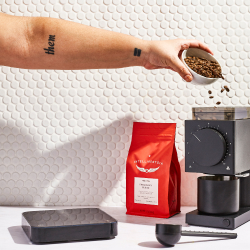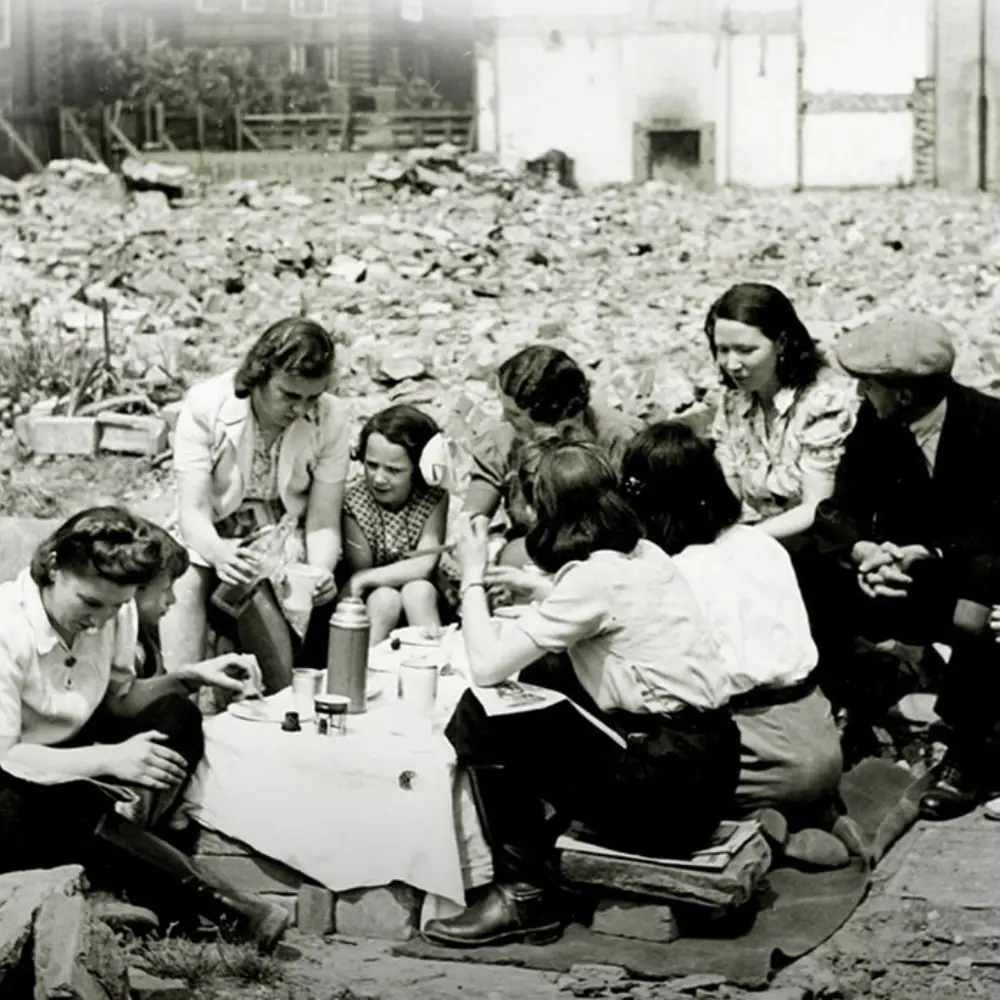In a world where the consumption of coffee has attained unparalleled levels of ubiquity, the Ethiopian Coffee Ceremony also known as “buna tetu” stands out as a veritably unique and fascinating tradition that has been celebrated for centuries. Rooted deeply in history, this ceremony provides an illuminating window into the exceedingly rich cultural tapestry of Ethiopia, the very birthplace of coffee itself.
In the course of this article, we will embark upon an enthralling odyssey, as we explore the multifaceted aspects of the art, customs, and flavors of the traditional Ethiopian coffee ceremony. From its hoary origins and profound cultural significance to the intricate and nuanced process of brewing and serving coffee, we will uncover the captivating beauty and symbolism that reside at the very core of this time-honored practice. Therefore, we invite you to accompany us as we plunge into the mesmerizing world of this cultural event and discover how you too can incorporate a modicum of this beguiling tradition into your own life.
Ethiopian Coffee Ceremony: Key Takeaway
- The Ethiopian Coffee Ceremony (buna tetu) is a cultural custom that celebrates Ethiopia’s coffee heritage and promotes social connections.
- The ceremony has deep historical roots in Ethiopia, the birthplace of coffee, and incorporates various cultural and spiritual elements.
- The ceremony involves multiple stages, showcasing the hostess’s skill in roasting, grinding, brewing, and serving coffee.
- Coffee is served in three rounds—Abol, Tona, and Baraka—symbolizing the deepening of connections between participants.
- The ceremony can be adapted for modern homes, allowing individuals to appreciate and share Ethiopian coffee traditions.
The Origins and Significance of the Ethiopian Coffee Ceremony
Buna tetu is not only a cherished tradition but also a reflection of the country’s deep connection with coffee. To understand the ceremony’s significance, we must first explore its historical roots and the roles it plays in Ethiopian society.
The Birthplace of Coffee: Ethiopia’s Kaffa Region
Ethiopia’s Kaffa region is widely regarded as the birthplace of coffee, where the story of Kaldi the goat herder, and his discovery of coffee beans is still told today. According to legend, Kaldi noticed that his goats became unusually energetic after consuming berries from a specific tree. Intrigued, he tried the berries himself and experienced the same stimulating effects. The news of this energizing fruit spread, and soon, the beans were being cultivated and used throughout Ethiopia and beyond. (1)

This cultural custom pays homage to this rich history by using locally sourced beans, typically harvested from wild coffee trees. This adds an extra layer of authenticity and cultural pride to the ritual, as participants appreciate the origins of the very drink they are consuming.
Cultural and Social Importance of the Ceremony
The traditional Ethiopian coffee ceremony is a custom that transcends mere coffee preparation and serving; it is a deeply entrenched social practice that fosters stronger bonds within communities. This ceremony, which can last for hours, presents an occasion for family, friends, and neighbors to come together, exchange stories, discuss local matters, and offer mutual support.

In countless Ethiopian homes, the coffee ceremony is a daily affair, viewed as an essential aspect of hospitality. Visitors are often invited to join in the ceremony, which represents respect, friendship, and an open invitation to engage in meaningful conversations.
Gender Roles and Responsibilities in the Ceremony
Traditionally, women are the custodians of the beautiful Ethiopian coffee ceremony, assuming the responsibility of roasting, grinding, and brewing the coffee, as well as serving it to the guests. The hostess, often attired in a traditional Ethiopian habesha kemis, not only plays a practical role in the ceremony but also embodies the values of hospitality, grace, and community that are integral to Ethiopian culture.
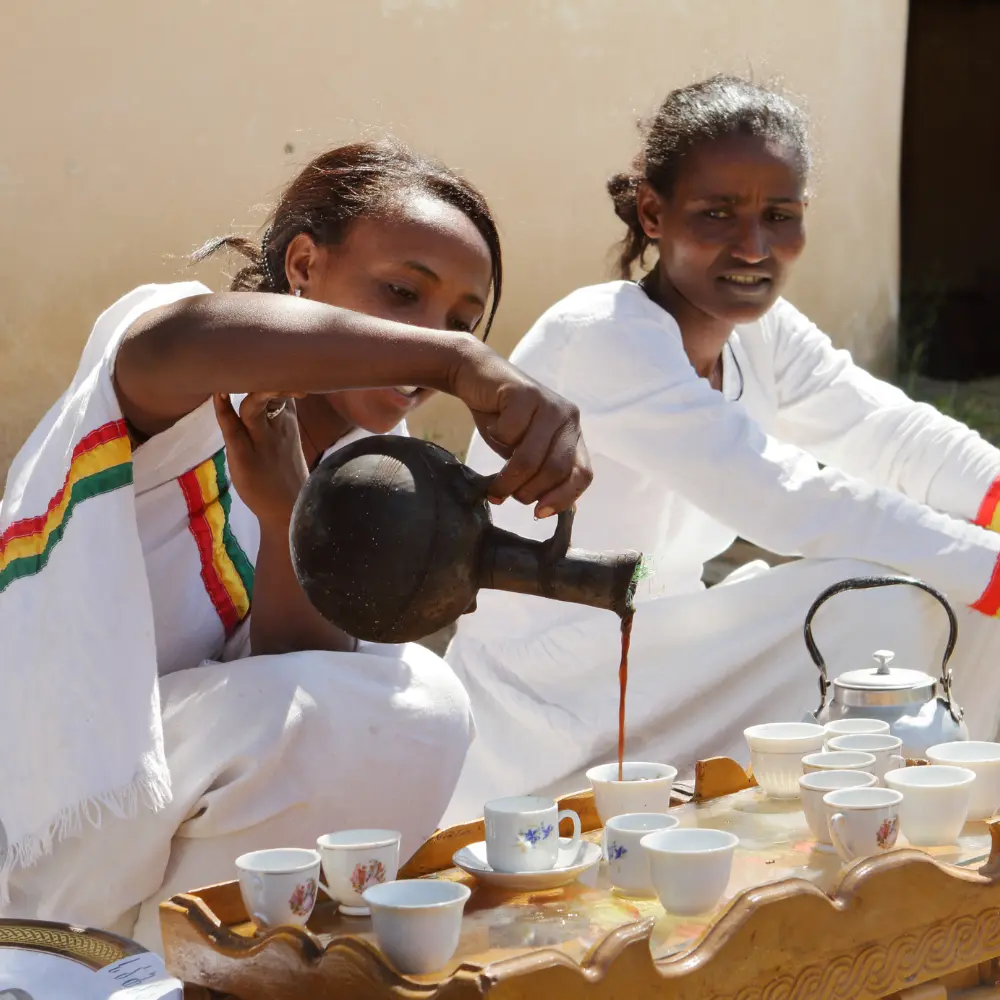
Recent years have witnessed a shift in some urban areas, with men and younger generations participating in the coffee ceremony. This development is indicative of evolving social norms and a growing appreciation for the rich history and cultural significance of the traditional Ethiopian coffee ceremony among all members of society.
The Ethiopian Coffee Ceremony Process
Buna tetu is an elaborate and intricate process comprising several stages, each with its own distinctive techniques and tools. From the initial roasting of the coffee beans to the final pour, each step is carried out with meticulous care and precision, culminating in a spellbinding experience for participants and onlookers alike.
Roasting the Coffee Beans
The first phase of the beautiful Ethiopian coffee ceremony entails the roasting of green coffee beans. This process commences with the hostess washing the beans to eliminate any impurities or debris. Once the beans are clean, they are placed in a flat pan or a traditional clay roasting dish called a menkeshkesh.
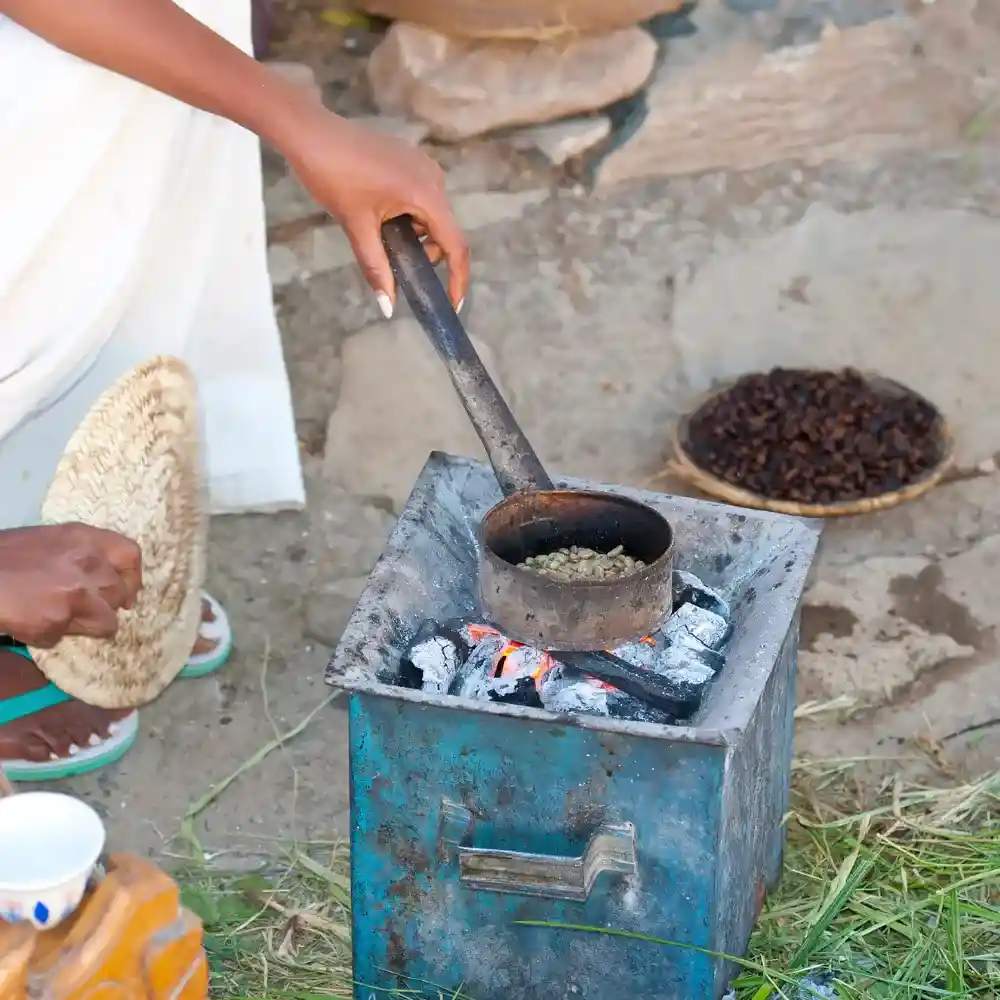
The beans are then roasted over an open flame, with the hostess constantly stirring them to ensure uniform roasting. As the beans gradually darken and exude a fragrant aroma, the pleasant scent permeates the atmosphere. The hostess may employ a small straw fan to waft the aroma toward the guests, allowing them to savor the aroma of the freshly roasted beans.
Grinding the Beans and Preparing the Jebena
Once the beans have been roasted to the desired level, they are left to cool for a short time before being ground. The grinding process is typically done using a traditional mortar and pestle called a mukecha and zenezena. This method of manual grinding not only produces a fine, even consistency but also adds a touch of authenticity to the ceremony.
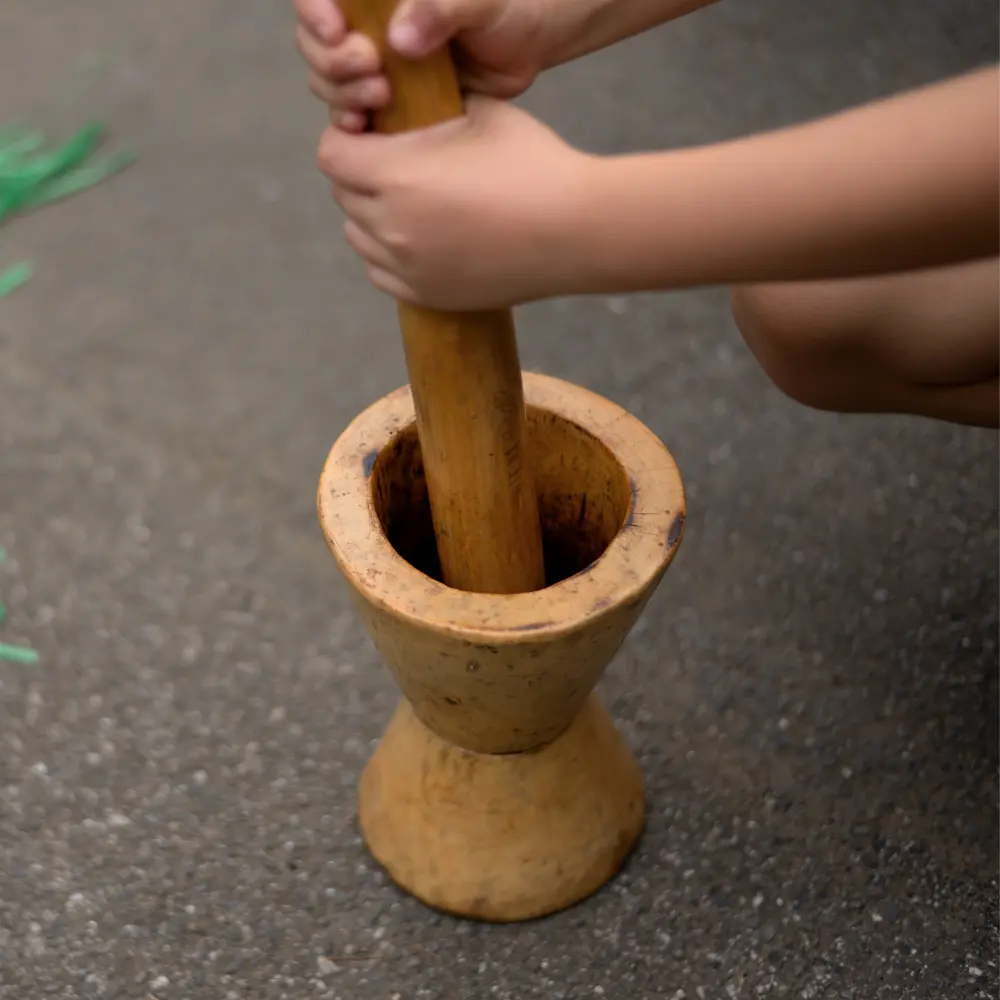
As the coffee beans are ground, the hostess will prepare the jebena, a distinctively shaped clay coffee pot with a round base, a long, slender neck, and a spout. The jebena is first filled with water and placed over a heat source, such as a charcoal brazier, to warm up. Once heated, the finely ground coffee is carefully added to the jebena.
Brewing and Serving the Coffee
With the ground coffee added to the jebena, the brewing process begins. The hostess monitors the heat carefully to ensure the coffee reaches the perfect temperature without boiling over. As the coffee brews, it produces a rich, dark liquid with a bold, complex flavor profile.
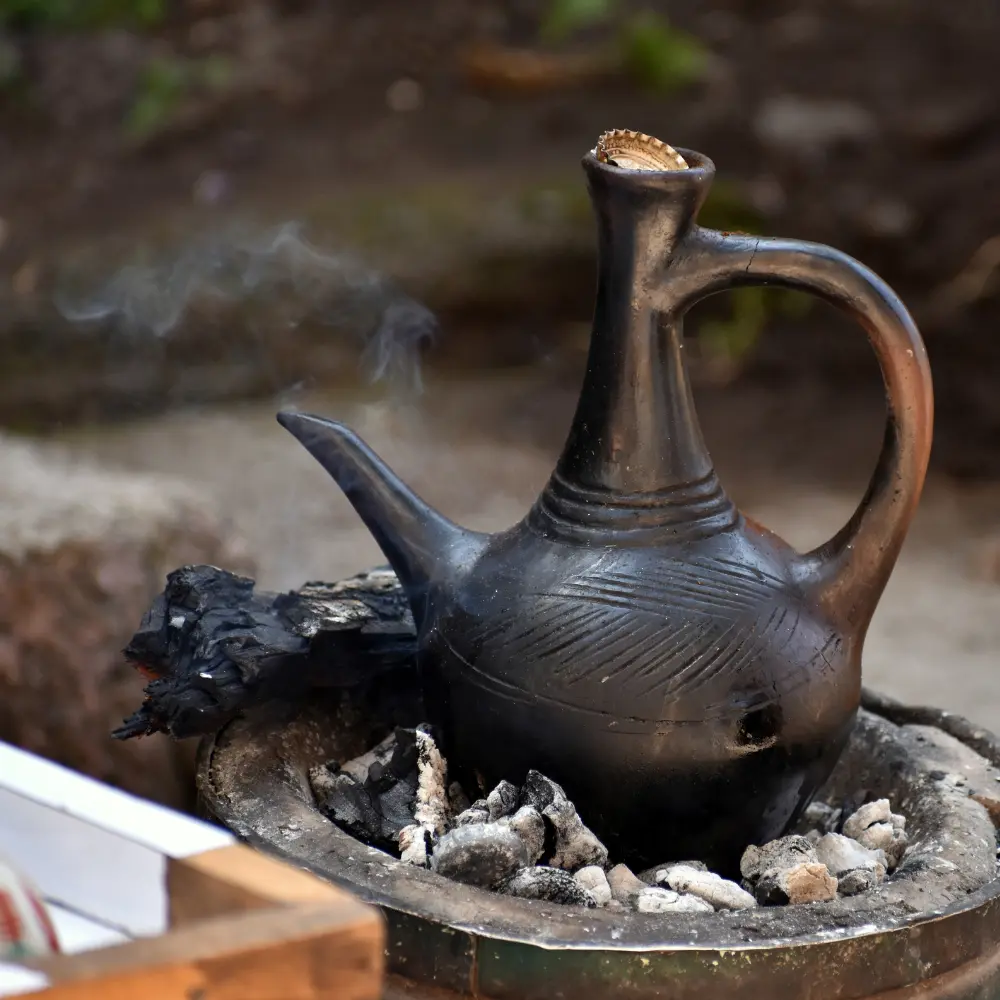
When the brewing process is complete, the hostess pours the coffee through a fine sieve to remove any remaining coffee grounds. The coffee is then served to the guests in small, handleless cups called sini or cini. The cups are traditionally arranged on a round tray known as a sini gebeya, which is often adorned with elaborate patterns or designs.
In a sign of respect and hospitality, the hostess serves the coffee starting with the eldest guest and proceeding in order of age. The coffee is typically served with sugar or salt, depending on regional preferences, and may be accompanied by snacks, such as popcorn or traditional Ethiopian bread called dabo. As the guests savor their coffee, the ceremony becomes a moment of shared appreciation for the rich flavors and deep cultural roots of the beautiful Ethiopian coffee ceremony.
The Art of the Ethiopian Coffee Table
Buna tetu is as much about the atmosphere as it is about the coffee itself. The setup and presentation of the coffee table play a crucial role in creating a warm and inviting environment for guests to gather and enjoy the experience together. Let’s explore the key elements of a traditional Ethiopian coffee table and the various accompaniments that enhance the sensory experience of the ceremony.
Traditional Coffee Ceremony Setup
The coffee table, known as rekbot, is the centerpiece of this cultural event. Traditionally made of wood or woven grass, the rekbot is often decorated with colorful cloths and patterns that reflect Ethiopian culture and heritage. The table is typically set on the floor, and guests sit on low stools or cushions surrounding it.

In addition to the rekbot, several essential items are arranged on or around the table. These include the jebena, the sini gebeya with sini cups, a brazier or charcoal stove to heat the water and roast the beans, and the menkeshkesh for roasting. The hostess will also have a mortar and pestle for grinding the beans and a pitcher of water for rinsing and cooling the beans during the roasting process.
Sweets and Snacks Accompanying the Coffee
An array of sweets and snacks are usually served alongside the coffee during the ceremony, providing a balance of flavors and textures to complement the bold taste of the coffee. Traditional Ethiopian snacks include popcorn, roasted barley, or a variety of bread, such as dabo (a type of wheat bread) or himbasha (a sweet, spiced bread). These snacks are placed on colorful plates or in woven baskets and arranged on the rekbot for guests to enjoy.
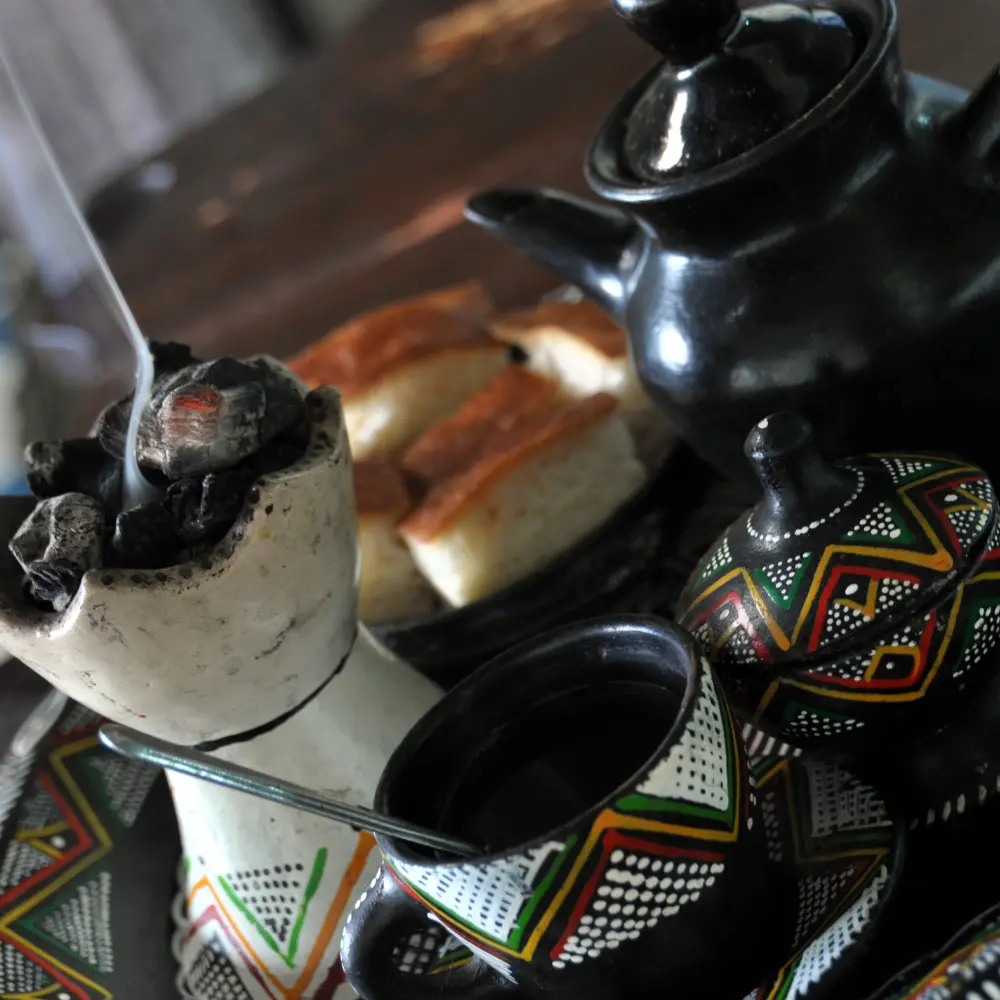
In Ethiopia, it is common to serve sugar or salt alongside the coffee, depending on local preferences, to customize the taste of coffee.
Incense and Aromatics: Adding Ambience to the Ceremony
This unique cultural custom is a multisensory experience, engaging not only the taste buds but also the sense of smell. To enhance the aromatic atmosphere of the ceremony, the hostess will often burn incense or fragrant herbs, such as frankincense or myrrh. The smoke from the incense fills the air, mingling with the aroma of the freshly roasted coffee beans to create an immersive sensory experience for the guests.

The use of incense and aromatics in the coffee ceremony serves a dual purpose. In addition to creating a welcoming and soothing atmosphere, it also carries spiritual and symbolic significance. The burning of incense is believed to ward off evil spirits and purify the space, ensuring that the ceremony unfolds in a harmonious and positive environment.
The Three Rounds of Coffee: Abol, Tona, and Baraka
This cultural custom comprises three distinct rounds of coffee, each with its unique name and significance. These rounds embody an indispensable element of the ceremony, as they symbolize the progression of the experience and the deepening of the connections between the participants. Let’s delve deeper into the three rounds of coffee and their distinct characteristics. (2)
The First Round: Abol
The first round of coffee also referred to as Abol, denotes the initiation of the ceremony. The coffee served in this round is brewed from the first round of roasted beans, resulting in the strongest and most concentrated coffee. The Abol coffee is then poured into small sini cups and served to the guests, who savor the robust flavors and appreciate the expertise and attentiveness of the hostess in preparing the brew.

As the guests relish their coffee, the conversations begin to flow, and the atmosphere becomes progressively more cordial and affable. The Abol round serves as an icebreaker, setting the stage for the deeper connections and dialogues that will unfold throughout the ceremony.
The Second Round: Tona
After the Abol round, the hostess replenishes the jebena with water and returns it to the heat source for a second round of brewing. This second round of coffee, known as Tona, is slightly mellower than the first, as the coffee grounds have already been utilized once. Nevertheless, it retains the distinct flavors and aromas that are characteristic of Ethiopian coffee.
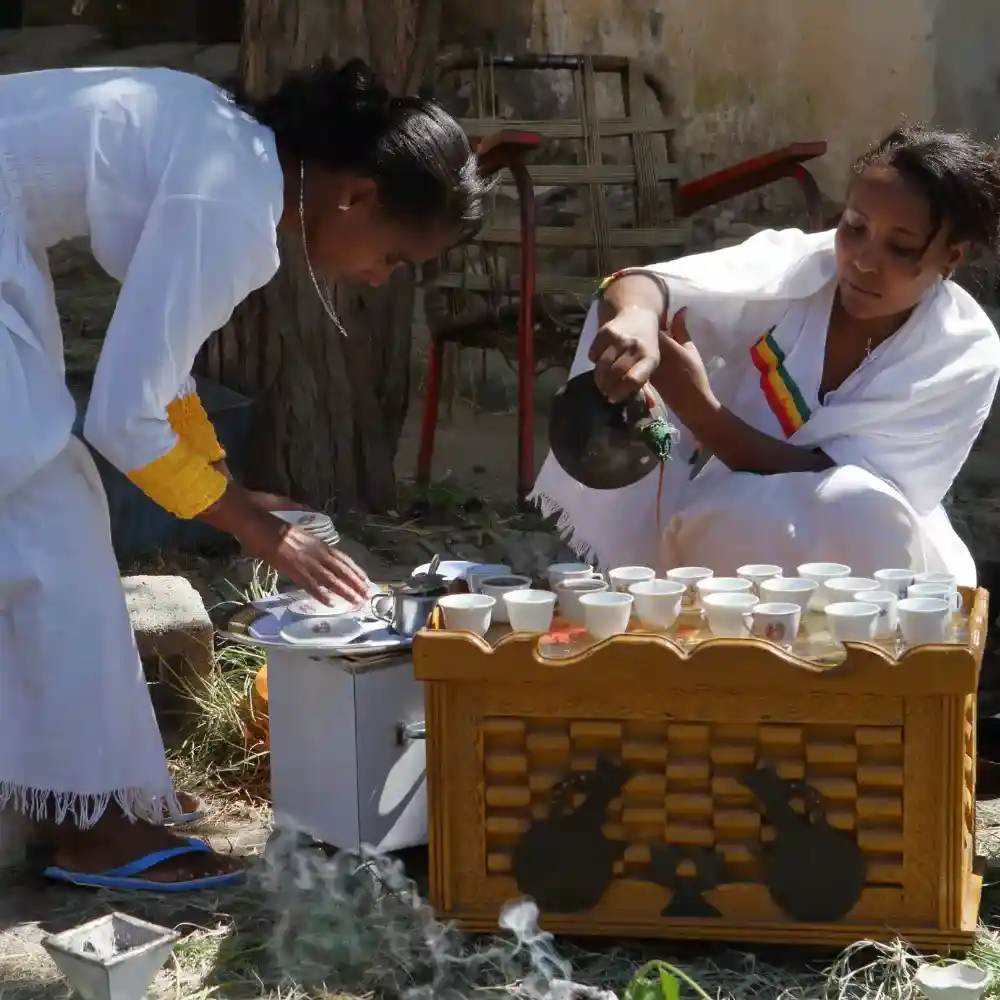
As the guests relish their Tona coffee, the conversation proceeds to delve into more personal and profound topics, facilitating a deepening of the connections between them and strengthening the bonds of camaraderie and community.
The Final Round: Baraka
The third and final round of coffee, referred to as Baraka, represents the most emblematic and spiritually significant aspect of the ceremony. The term “baraka” translates to “blessing” in Arabic, and the coffee served in this round is believed to bestow blessings upon those who partake of it.

Before serving the Baraka coffee, the hostess replenishes the jebena with water and allows the coffee to brew for the third time. This final brew is the mildest of the three, but it still retains a luscious and satisfying flavor. As the guests sip their Baraka coffee, the conversation reaches its apex, with participants sharing meaningful stories, pearls of wisdom, and advice.
The Baraka round serves as an apt conclusion to buna tetu, leaving participants with a sense of solidarity, warmth, and spiritual nourishment that endures well beyond the last sip of coffee.
Bringing the Ethiopian Coffee Ceremony Home
If you’re intrigued by this cultural event and eager to experience it in the comfort of your own home, you’re in luck. With a little bit of preparation and a few indispensable tools, you can recreate the ceremony and relish the exquisite flavors and cultural traditions. Here are some helpful tips to guide you in bringing buna tetu home.
Sourcing Ethiopian Coffee Beans
The first step in preparing for your buna tetu is to procure high-quality Ethiopian coffee beans. Seek out beans that are ethically sourced and grown in the country’s native coffee regions, such as Sidamo, Yirgacheffe, or Harrar. Numerous specialty coffee shops and online retailers offer an array of Ethiopian coffee beans, enabling you to select those that best suit your taste preferences. Remember that green, unroasted beans are indispensable for the ceremony, as they will be roasted during the process.
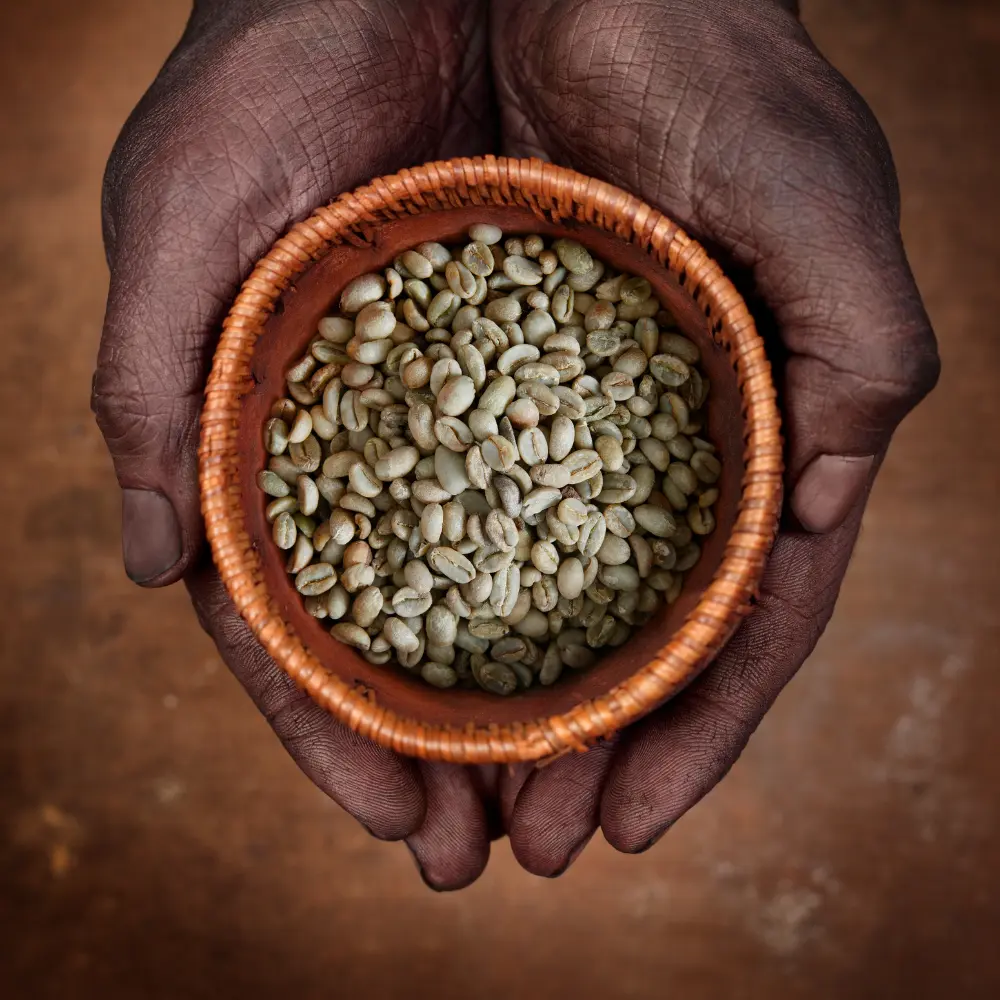
Essential Tools and Techniques for the Ceremony
To recreate an authentic buna tetu, you’ll need some essential tools and equipment. These include:
- A roasting pan or menkeshkesh for roasting the beans.
- A mortar and pestle (mukecha and zenezena) for grinding the roasted beans.
- A jebena for brewing the coffee.
- Sini cups for serving the coffee.
- A rekbot or low table for arranging the ceremony items.
While traditional Ethiopian tools will add authenticity to the ceremony, you can also use alternative equipment if these items are not readily available. For example, you can use a standard frying pan for roasting the beans, a manual coffee grinder for grinding, and a French press or Moka pot for brewing the coffee.
Once you have gathered the necessary tools, familiarize yourself with the techniques involved in each stage of the ceremony, from roasting and grinding the beans to brewing and serving the coffee. Practicing these techniques will help you feel more confident and comfortable when performing the ceremony for your guests.
Incorporating the Ceremony into Your Daily Life
While this cultural event is traditionally performed as a social event, you can also incorporate elements of the ceremony into your daily life as a way to connect with the rich heritage and flavors of Ethiopian coffee. By roasting, grinding, and brewing your coffee using traditional methods, you can create a deeper appreciation for the process and enjoy a more immersive sensory experience.
You might also consider hosting a buna tetu for friends and family, as a way to share the beauty and warmth of this tradition with your loved ones. Whether you choose to perform the ceremony daily or on special occasions, it offers a unique opportunity to slow down, savor the moment, and forge meaningful connections through the shared experience of coffee.
Conclusion
In conclusion, this cultural custom is an exuberant and dynamic tradition that exemplifies the profound cultural heritage and communal values of Ethiopian society. This enchanting ritual beckons participants to embark on a journey through the history, culture, and flavors of one of the world’s most revered coffee-producing countries. By examining the origins and importance of the ceremony, the intricate process involved in preparing the coffee, and the sensory pleasures of the coffee table, we gain a deeper appreciation for the splendor and intricacy of buna tetu.
Whether you decide to recreate the ceremony at home or merely relish Ethiopian coffee in your daily life, this cultural custom serves as a potent reminder of the significance of connection, hospitality, and collective experiences. It invites us to decelerate, relish the moment, and treasure the bonds we create with others over a hot cup of coffee. Embracing this time-honored tradition can enrich our lives and augment our comprehension of the diverse and captivating cultures of the world.
FAQ
What is the history of the Ethiopian Coffee Ceremony?
The history of buna tetu is deeply rooted in the origin of coffee itself. Ethiopia is considered the birthplace of coffee and the coffee ceremony evolved as a means to celebrate and share this valuable resource, incorporating various cultural and spiritual elements over time. The ceremony has been passed down through generations and remains a cornerstone of Ethiopian culture and social life.
How does the Ethiopian Coffee Ceremony promote community and connection?
This cultural event promotes community and connection by creating a welcoming and inclusive atmosphere for participants to gather, converse, and share experiences. The ceremony encourages guests to slow down, savor the coffee, and engage in meaningful conversations. As the coffee is served in three distinct rounds, the bonds between participants deepen, reinforcing a sense of unity and friendship.
What are the key components of a traditional Ethiopian coffee table?
A traditional Ethiopian coffee table, or rekbot, is the centerpiece of the coffee ceremony. It is typically made of wood or woven grass and adorned with colorful cloths and patterns reflecting Ethiopian culture. Essential items arranged on or around the table include the jebena (coffee pot), sini cups (serving cups), a brazier or charcoal stove, menkeshkesh (roasting pan), mortar and pestle (mukecha and zenezena), and a pitcher of water. Sweets and snacks, such as popcorn, roasted barley, or bread, are also served alongside the coffee.
How do the three rounds of coffee differ in the Ethiopian Coffee Ceremony?
Buna tetu consists of three rounds of coffee, each with its name and significance. The first round, Abol, features the strongest and most concentrated brew. The second round, Tona, is slightly milder, as the coffee grounds have already been used once. The third and final round, Baraka, is the mildest of the three and carries spiritual significance, as it is believed to bestow blessings upon those who partake in it.
Can the Ethiopian Coffee Ceremony be adapted for a modern home setting?
Yes, this cultural custom can be adapted for a modern home setting. By sourcing high-quality Ethiopian coffee beans and acquiring essential tools, such as a roasting pan, mortar and pestle, jebena, and sini cups, you can recreate the ceremony in your own home. Traditional Ethiopian tools can be substituted with alternative equipment if necessary. Incorporating elements of the ceremony into your daily life or hosting occasional coffee ceremonies for friends and family can enrich your appreciation of Ethiopian culture and coffee traditions.

